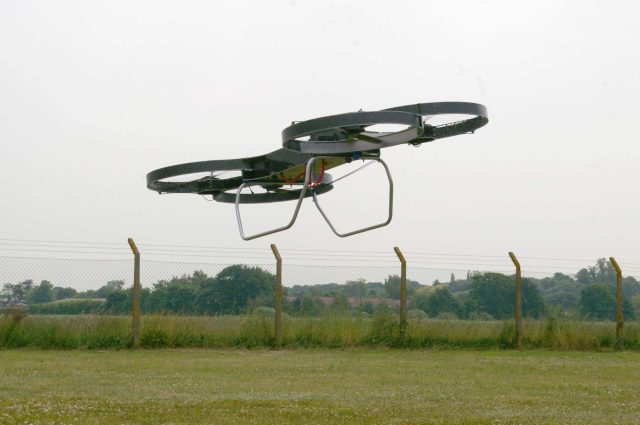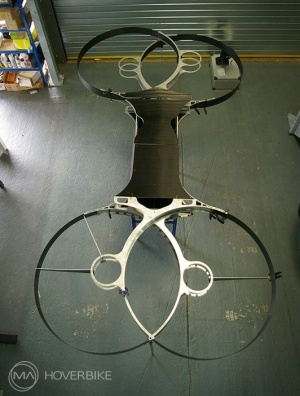
The British-made Malloy Hoverbike, which burst onto the scene last year as a Kickstarter project, is being picked up by the US Department of Defense. The DoD is looking at the hoverbike as a multiple-role transport craft: it can transport soldiers over difficult terrain, but it can also operate in drone mode, providing logistical or surveillance support.
The Malloy Hoverbike, developed by Malloy Aeronautics (MA) in Berkshire, began its life as a bi-copter: a carbon fibre chassis with a motorbike engine in the middle, with two very large props at the front and back. If you squinted, it looked a bit like a motorbike or perhaps a Star Wars speeder bike. However, the bi-copter design was eventually dropped in favour of a conventional quadcopter design because "with current technology we could not design a bi-copter cheap enough for safe and competitive sales."
The current version of the Malloy Hoverbike is essentially a giant, sit-on quadcopter. The only real difference is that its rotors are off-set so that they overlap, which reduces both the width of the craft and the weight. The petrol engine is gone, presumably in favour of electric motors and lithium-ion batteries (MA hasn't revealed the exact specs, but it's still very much in the prototype stage anyway). The P2 Hoverbike seen below is apparently capable of lifting 100 kilos (220 pounds).
At the Paris Air Show last week, Malloy Aeronautics announced a partnership with Maryland-based Survice Engineering, a long-time US DoD defense contractor, to develop and manufacture the hoverbike in Maryland. The hoverbike will be developed with the US Army Research Laboratory (ARL) which sees the hoverbike as "a new class of Tactical Reconnaissance Vehicle (TRV)."
According to Survice's Mark Butkiewicz, as reported by Reuters, "The Department of Defense is interested in Hoverbike technology because it can support multiple roles. It can transport troops over difficult terrain and when it's not used in that purpose it can also be used to transport logistics, supplies, and it can operate in both a manned and unmanned asset. It can also operate as a surveillance platform."

Malloy Aeronautics ultimately sees its hoverbike as a drop-in replacement for many roles that are currently performed by helicopter. Operating a helicopter is really expensive, and MA thinks there are cases where the US Army could use a hoverbike instead, such as moving troops and supplies around, low-altitude reconnaissance, etc. The adducted and housed rotor blades should also make the hoverbike safer for close-quarter work, too: you don't have to worry so much about hitting obstacles or lopping limbs off humans.
Like state-of-the-art quadcopters, the Malloy Hoverbike will be capable of a few different modes of operation: a soldier can sit on it (though it isn't clear how they will pilot it); it can follow a pre-determined flight path, perhaps while loaded down with supplies or to surveil an area; or it be told to follow the controller, as some kind of pack mule.
There is no timeline for the deployment of the hoverbike in the US Army. The next step, according to Butkiewicz, is to "construct prototypes that meet military requirements."
It's also worth pointing out that the Department of Defense has been developing various hoverbikes and other helicopter alternatives since the 1950s, without much success. With the recent maturity of quadcopter tech and light-weight lithium-ion batteries, though, it might actually work out this time.
reader comments
71